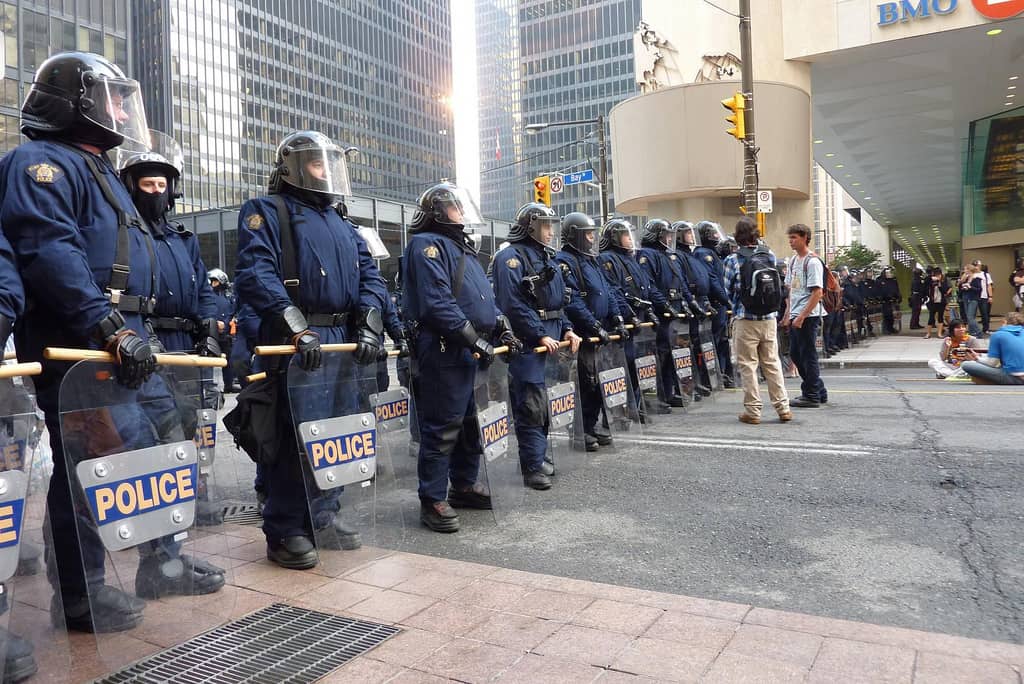Daniel Vandervoort was not too upset that his iPod was never returned after police searched the Graduate Students’ Union (GSU) building during the G20 summit, even though he couldn’t afford to replace it. Vandervoort says he lost something else that morning, something that no amount of money can replace: his trust and confidence in the police.
Vandervoort, then-external commissioner for the GSU, was sleeping overnight in the GSU gymnasium during the G20, along with over a hundred other people; many had recently arrived from Quebec and British Columbia. They were abruptly awoken when police entered the GSU-operated building at 16 Bancroft Ave. on the morning of June 27, 2010 and arrested all those present, in a move that Ontario’s police watchdog says was “unlawful.” Senior-ranking Toronto police officer Inspector Gary Meissner, who oversaw the raid on the GSU building and the subsequent arrests, is now facing possible internal police disciplinary action.
According to a 286-page report released by the Office of the Independent Police Review Director (OIPRD) in May, police believed that protestors who used “Black Bloc” tactics to vandalize downtown property the previous day might be connected to student groups in the area and thus that students inside the GSU building might have been involved in the previous day’s illegal activities.
The report devotes an entire chapter to the events alleged to have transpired inside the GSU building that Sunday morning. It concludes that the mass arrest was unlawful because the police did not obtain an arrest warrant, and did not have grounds to believe that the gymnasium’s occupants had committed the offence of unlawful assembly.
During the mass arrest, the gym’s occupants were told that they were being arrested for unlawful assembly. An officer from the Montreal police department was brought in to translate to French-speaking occupants in the gym; these occupants later told the OIPRD that the charge communicated in French was “participating in a riot.” Later that day, the charge was changed to conspiracy to commit an indictable offence — mischief. According to the report, 108 people were arrested at the GSU building in total.
All charges stemming from the GSU arrest were dropped in October 2010.
In testimony provided to OIPRD, and repeated in interviews with The Varsity, Vandervoort claimed he was zip-tied and searched while up against a wall. According to his account, he objected after an officer violently searched him and grabbed his genitals twice; the officer then put him in a chokehold, pushed his head against the wall and stamped on his shin before disappearing into the crowded gymnasium.
Vandervoort said he spent the next two nights sleeping in his pyjamas on concrete floors at the detention centre, while the open wound on his shin swelled up. His lawyer came and left after failing to find him amid the chaos and confusion.
Toronto Police Services (TPS) declined to comment on the grounds that Meissner’s case will soon progress to hearings.
“A lot of generalizations and faults in logic led the police to this unlawful arrest,” said Vandervoort. “The approach of arresting everybody and sorting it out later is not a just way to go about your business.”
According to the report, a private investigator hired by the University of Toronto campus police told TPS that he photographed people outside of the GSU building wearing “Black Bloc attire,” a tip that appears to have contributed to the police belief that criminals were being harboured within the GSU building.
Dan Hutt, director of Campus Police Services, told The Varsity in an email that campus police occasionally hires external help to cope with large-scale events. For the G20 summit, they hired a retired TSP officer for a week.
“His job was to take pictures of buildings before the G20 started and during the G20, so that if buildings were damaged or people were hurt, we had pictures for both insurance and safety purposes,” Hutt wrote.
Hutt added that the private investigator was asked to photograph what was happening on Bancroft Avenue on Saturday morning, when a large number of people — many of whom were not U of T students — appeared to have gathered there.
“This is standard practice when there is a disturbance or concern about student and public safety,” Hutt wrote.
The private investigator handed the photographs over to TPS upon request. Hutt said Campus Police later erased the photographs.
The GSU billets students and community members for conferences and other events on a regular basis, but the scale of the G20 billeting was unprecedented according to Brad Evoy, internal commissioner of the GSU and chair of the space-use subcommittee.
Evoy said there were mixed reactions toward the union’s actions from the university community after the G20 events, but the union does not see a need to change its billeting policies any time soon.
“There was support, apprehension and confusion,” said Evoy. “What [the OIPRD report] shows quite clearly is the policies of the union at the time were sound, and the actions of the police were what were truly unlawful and disturbing.”
-With files from the Toronto Star.


